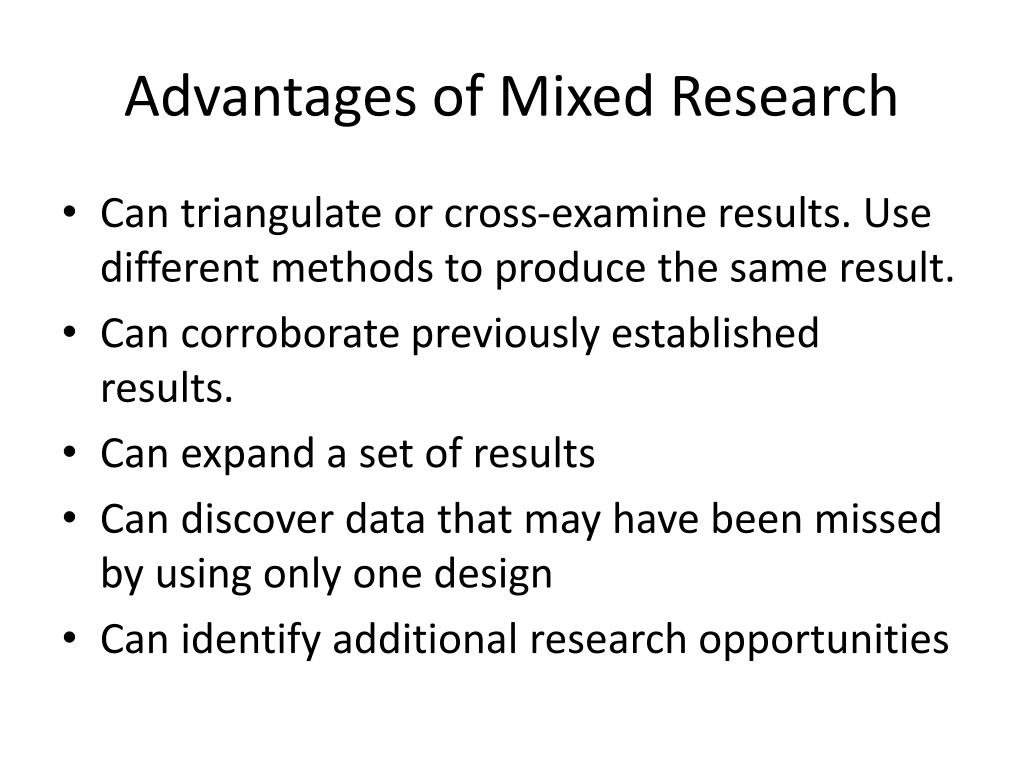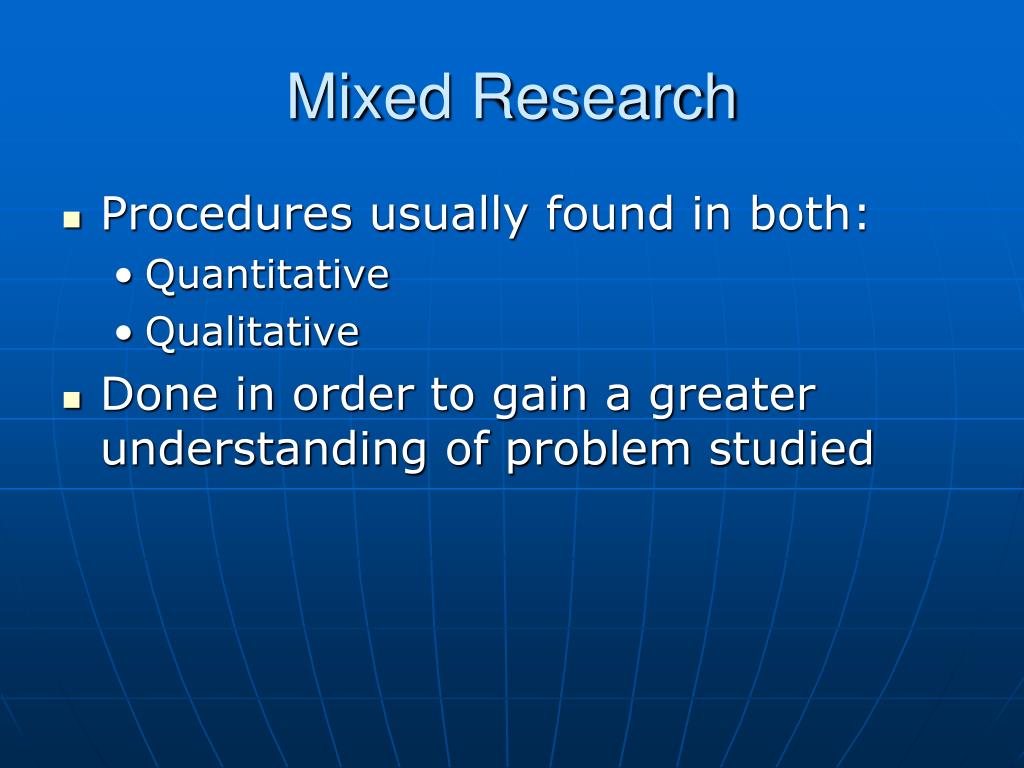Table Of Content

Quantitative data collected through surveys or experiments can be analyzed using statistical methods. Statistical analysis can be used to identify relationships between variables, test hypotheses, and make predictions. Common statistical methods used in quantitative data analysis include regression analysis, t-tests, ANOVA, and correlation analysis. Experimentation is a quantitative data collection method that involves manipulating one or more variables and measuring their effects on an outcome.
Latest articles
The aim is to understand these agents’ engagement in MMR, as well as its distinctive content as being informed by their position in this field. Viewing MMR as a position-taking of academic entrepreneurs, linked to their objective position in this field, allows us to reflect sociologically on the substance of the approach. To get ahead of the discussion, these problems have to do with the framing of MMR as a distinct methodology and its specific conceptualization of data and methods of data analysis. We argue that these problems hinder fruitfully combining methods in a practical understanding of social scientific research. Finally, we conclude with some tentative proposals for an alternative view on combining methods. In addition to the six primary design dimensions or considerations, we provided a set of additional or secondary dimensions/considerations or questions to ask when constructing a mixed methods study design.
A bibliometric analysis of the use of the Gamification Octalysis Framework in training: evidence from Web of Science
The dominated groups at this side of the field will cater more to practitioners or professionals outside of the field of science. Possessing less scientific capital, they hold less consecrated positions and their chances of introducing successful innovations are much lower. One is to revert to a strategy of adaptation, accepting the established hierarchy in the field and embarking on a slow advancement to gain the necessary capital to make their mark from within the established order. However, Bourdieu notes that sometimes agents with a relatively marginal position in the field will engage in a “flight forward” and pursue higher risk strategies.
Explanatory Research – Types, Methods, Guide
In summary, the small group of researchers who have been identified as the core of MMR consist predominantly of users of methods, who were educated and have worked exclusively at US and British universities. Its origins and circulation in vocational studies rather than classical academic disciplines can be understood from the position these studies occupy in the scientific field and the kinds of position-taking and innovations these positions give rise to. This context allows a reflexive understanding of the content of MMR and the issues that are dominant in the approach. Creswell and Plano Clark thus locate the emergence of “MMR proper” at the second stage, when researchers started to use both qualitative and quantitative methods within a single research effort. They lay the groundwork for MMR as a separate subfield with its own identity, topics, problems and intellectual history.
Purpose of Mixed Methods Research
(PDF) Exploring the Distinctions between Quantitative and Qualitative Research Methods - ResearchGate
(PDF) Exploring the Distinctions between Quantitative and Qualitative Research Methods.
Posted: Wed, 24 Jan 2024 08:00:00 GMT [source]
For more information on how to articulate design complexity based on multiple purposes of mixing, see Schoonenboom et al. (2017). The common complexity of mixed methods design poses a problem to the above typologies of mixed methods research. The typologies were designed to classify whole mixed methods studies, and they are basically based on a classification of simple designs. Complex designs are sometimes labeled “complex design”, “multiphase design”, “fully integrated design”, “hybrid design” and the like.
Similar content being viewed by others
This clearly depicts that mixed-methods research is still in its infancy stage in nursing but we can say there is huge scope to implement it to understand research questions on both sides of coin [4]. Therefore, there is a great need for mixed-methods training to enhance the evidence-based decision making in health and nursing practices. We critically reviewed the emerging practice of combining methods under the label of MMR.
Mixed methods research is a great choice when quantitative or qualitative data alone will not sufficiently answer a research question. By collecting and analyzing both quantitative and qualitative data in the same study, you can draw more meaningful conclusions. We should also recognize that the participants were OPLWH who might be unable to access particular technologies, or who may be unfamiliar with using technologies such as web applications. Other studies have also found that more comprehensive interventions can require a caregiver or other person to assist patients [30]. Participants were likely to be satisfied with the entertaining features embedded in the gamified online role-play.
About this article
Through a mixed methods approach, researchers could more easily compare and contrast their results to better understand the phenomenon as a whole. For example, let's say you are conducting a survey about consumer preferences for a certain product. You could collect only quantitative data, such as how many people prefer each product and their demographics. Or you could supplement your quantitative data with qualitative data, such as interviews and focus groups, to get a better sense of why people prefer one product over another. Mixed methods research is a popular method for researching today, allowing for a deeper exploration of a research question by utilizing a blend of qualitative and quantitative data. The laboratory parameters measured the effectiveness of the home telehealth model for older persons living with hemodialysis by comparing the significant differences between the experimental and control groups before the experiment, 3 months after, and 6 months after.

The qualitative phase was afterwards conducted to explore in-depth information through semi-structured interviews, in order to enhance an understanding of the quantitative phase, and to develop a conceptual framework for designing and implementing an online role-play for training teledentistry. One of these must surely be the data-theoretical elements that different methods incorporate. The problematization of data has become all the more pressing now that the debate about the consequences of “big data” for social scientific practices has become prominent (Savage and Burrows 2007; Levallois et al. 2013; Burrows and Savage 2014). Whereas MMR emphasizes the dichotomy between qualitative and quantitative data, a historical analysis of the production and use of methods can explore the more subtle, different interpretations and enactments of the “same” data. These differences inform method construction, controversies surrounding methods and, hence, opportunities for combining methods.
The design and evaluation of gamified online role-play as a telehealth training strategy in dental education: an ... - Nature.com
The design and evaluation of gamified online role-play as a telehealth training strategy in dental education: an ....
Posted: Mon, 22 Apr 2024 15:44:49 GMT [source]
The combination of effective telehealth and a continuum of healthcare will increase understanding of health, patient outcomes, and the cost of care. Previous studies have suggested that interprofessional care management or home monitoring could improve intermediate outcomes of CKD patients [13]. Based on the qualitative findings, a conceptual framework was developed in which a gamified online role-play was conceptualized as a learning strategy in supporting learners to be able to implement teledentistry in their clinical practice (Fig. 4). The qualitative data retrieved from semi-structured interviews were analyzed using a framework analysis, where its procedure involved transcription, familiarization with the interview data, coding, developing an analytical framework, indexing, charting, and data interpreting qualitative findings48. In this research, the initial codes had been pre-defined from previous literature and subsequently adjusted following the analysis of each transcript to develop an analytical framework (themes and subthemes), requiring several iterations until no additional codes emerged. Subsequently, the established categories and codes were applied consistently across all transcripts (indexing).
When they (later on in the text) provide two methodological principles that differentiate MMR from other communities of scholars, they state that they regard it as a “crucial mission” for the MMR community to generate distinct methodological principles (Tashakkori and Teddlie 2010b, pp. 16–17). They envision an MMR methodology that can function as a “guide” for selecting specific methods. For instance, Morgan (2007) and Hesse-Biber (2010) consider pragmatism as a philosophy that distinguishes MMR from qualitative (constructivism) and quantitative (positivist) research and that can provide a rationale for the paradigmatic pluralism typical of MMR.
No comments:
Post a Comment